Numeracy and Data Analysis Report: Application of Forecasting
VerifiedAdded on 2023/06/15
|10
|1783
|228
Report
AI Summary
This report delves into the application of numeracy and data analysis, utilizing statistical tools such as mean, median, mode, range, standard deviation, and linear regression. It includes a table and charts illustrating humidity temperature data collected over ten consecutive days in Scotland. The report demonstrates the calculation of mean, mode, median, range, and standard deviation using the provided data set, outlining the steps for each calculation. Furthermore, it applies linear regression to calculate the values of 'm' and 'c' and forecasts the humidity temperature for the 11th and 12th days, concluding with a summary of findings and their implications for understanding data analysis and numeracy concepts. Desklib provides access to this and other student-contributed assignments.
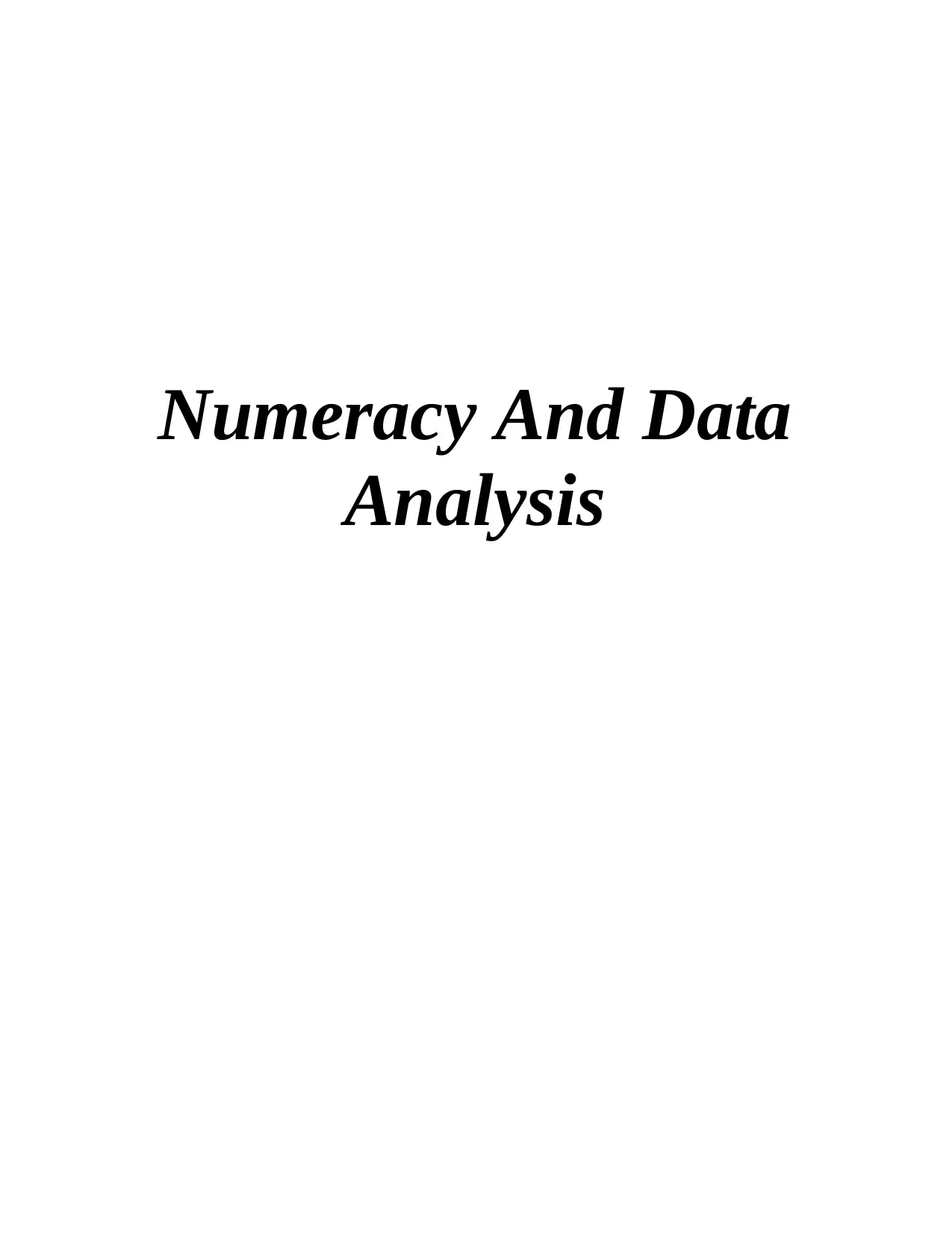
Numeracy And Data
Analysis
Analysis
Paraphrase This Document
Need a fresh take? Get an instant paraphrase of this document with our AI Paraphraser
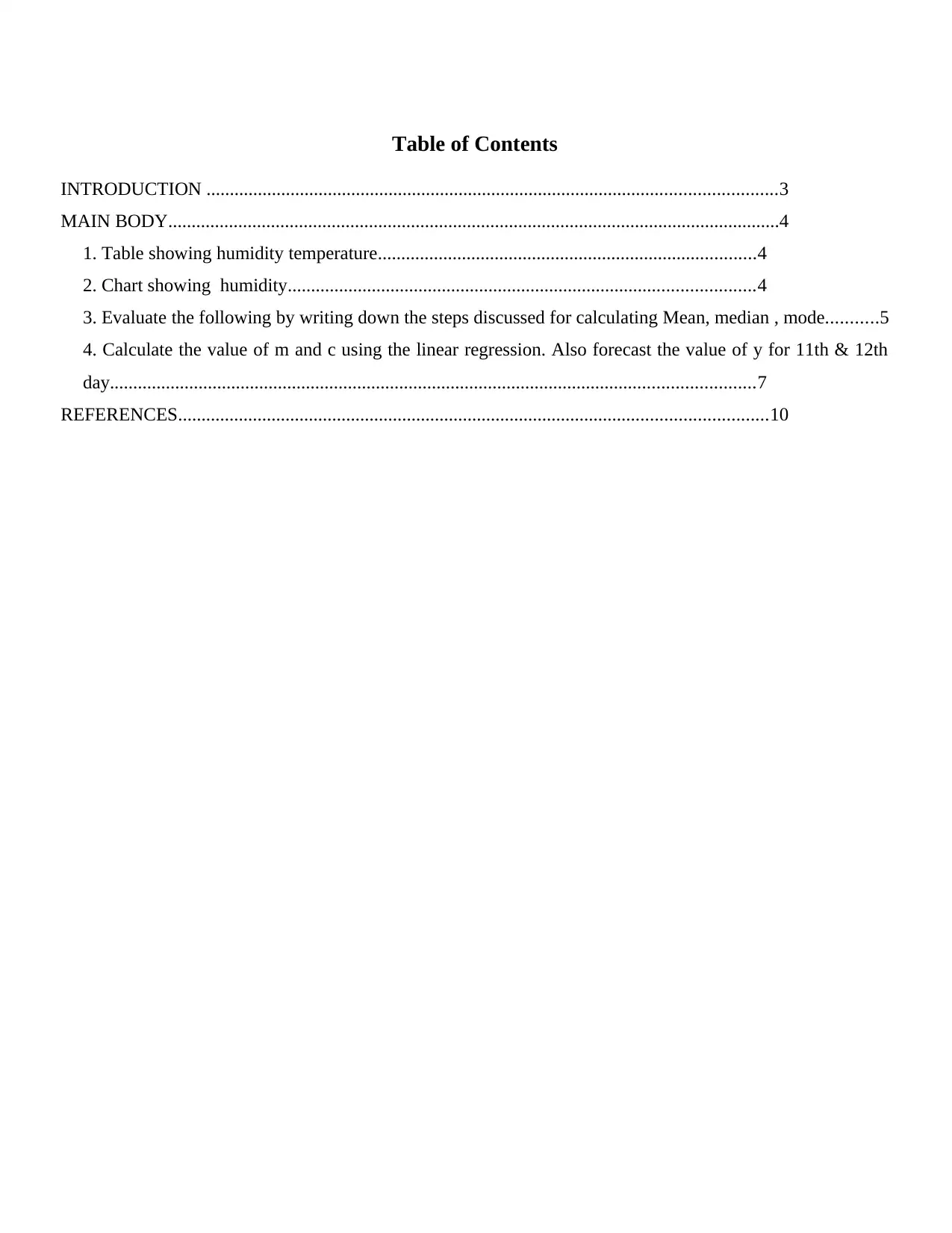
Table of Contents
INTRODUCTION ..........................................................................................................................3
MAIN BODY...................................................................................................................................4
1. Table showing humidity temperature.................................................................................4
2. Chart showing humidity....................................................................................................4
3. Evaluate the following by writing down the steps discussed for calculating Mean, median , mode...........5
4. Calculate the value of m and c using the linear regression. Also forecast the value of y for 11th & 12th
day..........................................................................................................................................7
REFERENCES..............................................................................................................................10
INTRODUCTION ..........................................................................................................................3
MAIN BODY...................................................................................................................................4
1. Table showing humidity temperature.................................................................................4
2. Chart showing humidity....................................................................................................4
3. Evaluate the following by writing down the steps discussed for calculating Mean, median , mode...........5
4. Calculate the value of m and c using the linear regression. Also forecast the value of y for 11th & 12th
day..........................................................................................................................................7
REFERENCES..............................................................................................................................10
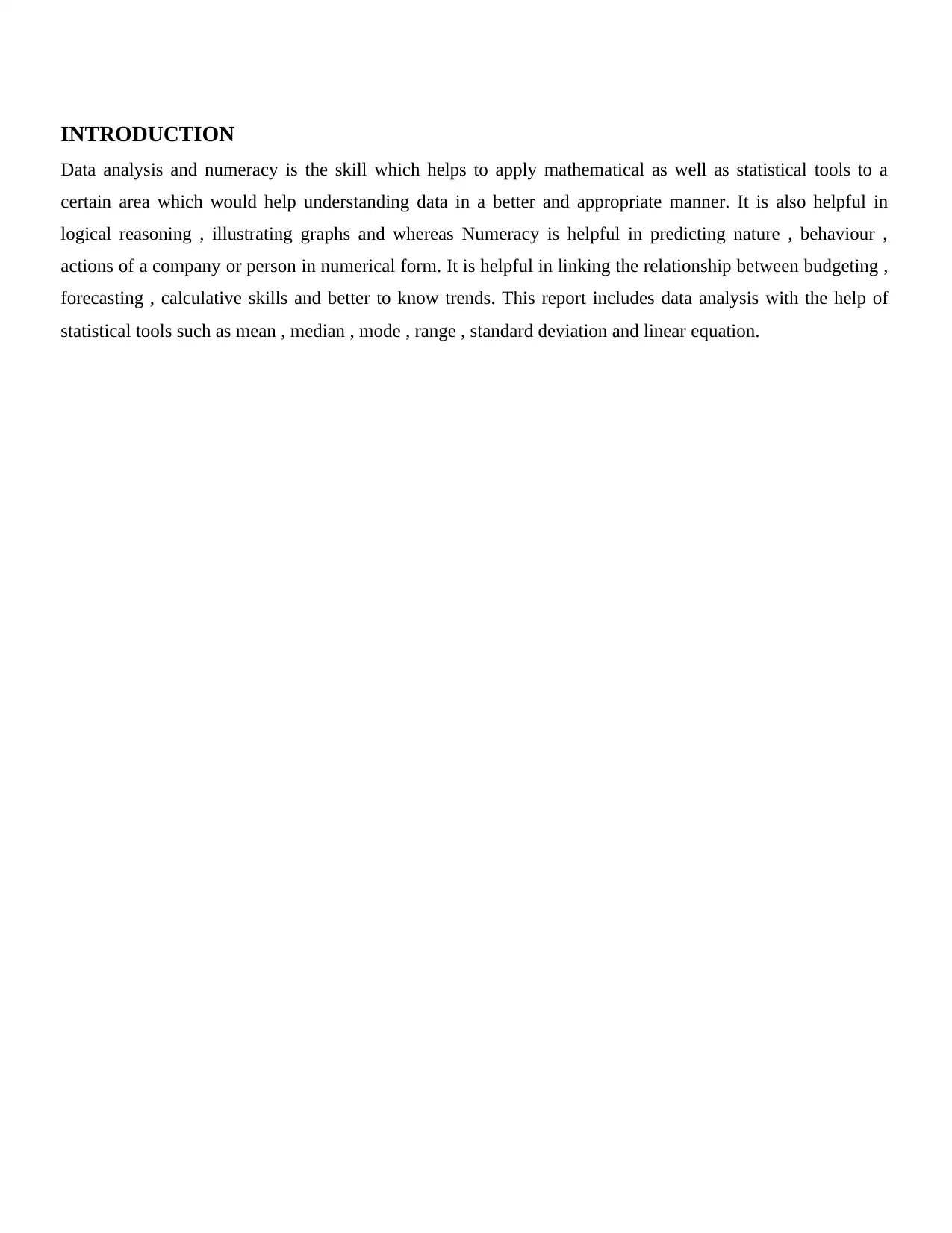
INTRODUCTION
Data analysis and numeracy is the skill which helps to apply mathematical as well as statistical tools to a
certain area which would help understanding data in a better and appropriate manner. It is also helpful in
logical reasoning , illustrating graphs and whereas Numeracy is helpful in predicting nature , behaviour ,
actions of a company or person in numerical form. It is helpful in linking the relationship between budgeting ,
forecasting , calculative skills and better to know trends. This report includes data analysis with the help of
statistical tools such as mean , median , mode , range , standard deviation and linear equation.
Data analysis and numeracy is the skill which helps to apply mathematical as well as statistical tools to a
certain area which would help understanding data in a better and appropriate manner. It is also helpful in
logical reasoning , illustrating graphs and whereas Numeracy is helpful in predicting nature , behaviour ,
actions of a company or person in numerical form. It is helpful in linking the relationship between budgeting ,
forecasting , calculative skills and better to know trends. This report includes data analysis with the help of
statistical tools such as mean , median , mode , range , standard deviation and linear equation.
⊘ This is a preview!⊘
Do you want full access?
Subscribe today to unlock all pages.

Trusted by 1+ million students worldwide
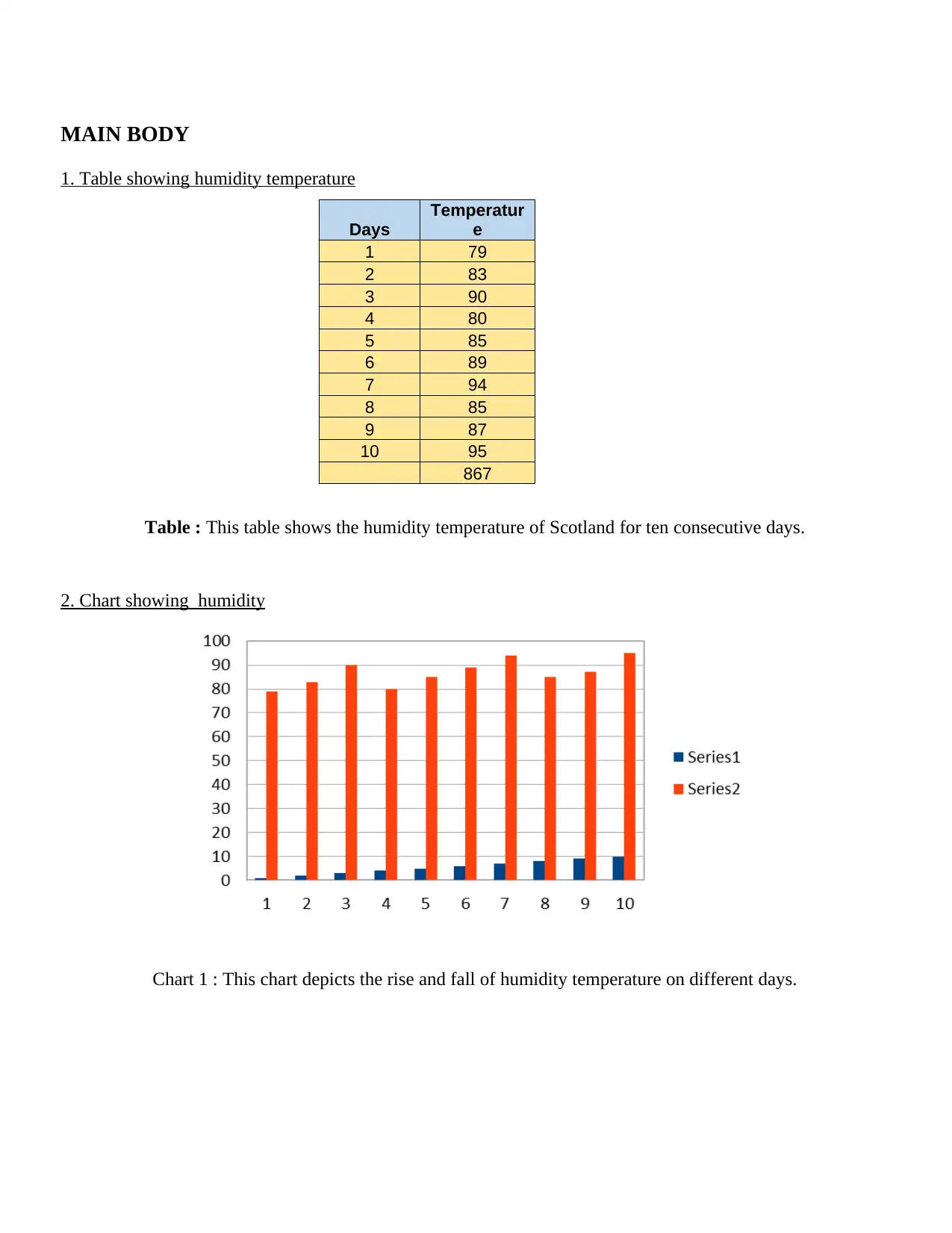
MAIN BODY
1. Table showing humidity temperature
Days
Temperatur
e
1 79
2 83
3 90
4 80
5 85
6 89
7 94
8 85
9 87
10 95
867
Table : This table shows the humidity temperature of Scotland for ten consecutive days.
2. Chart showing humidity
Chart 1 : This chart depicts the rise and fall of humidity temperature on different days.
1. Table showing humidity temperature
Days
Temperatur
e
1 79
2 83
3 90
4 80
5 85
6 89
7 94
8 85
9 87
10 95
867
Table : This table shows the humidity temperature of Scotland for ten consecutive days.
2. Chart showing humidity
Chart 1 : This chart depicts the rise and fall of humidity temperature on different days.
Paraphrase This Document
Need a fresh take? Get an instant paraphrase of this document with our AI Paraphraser
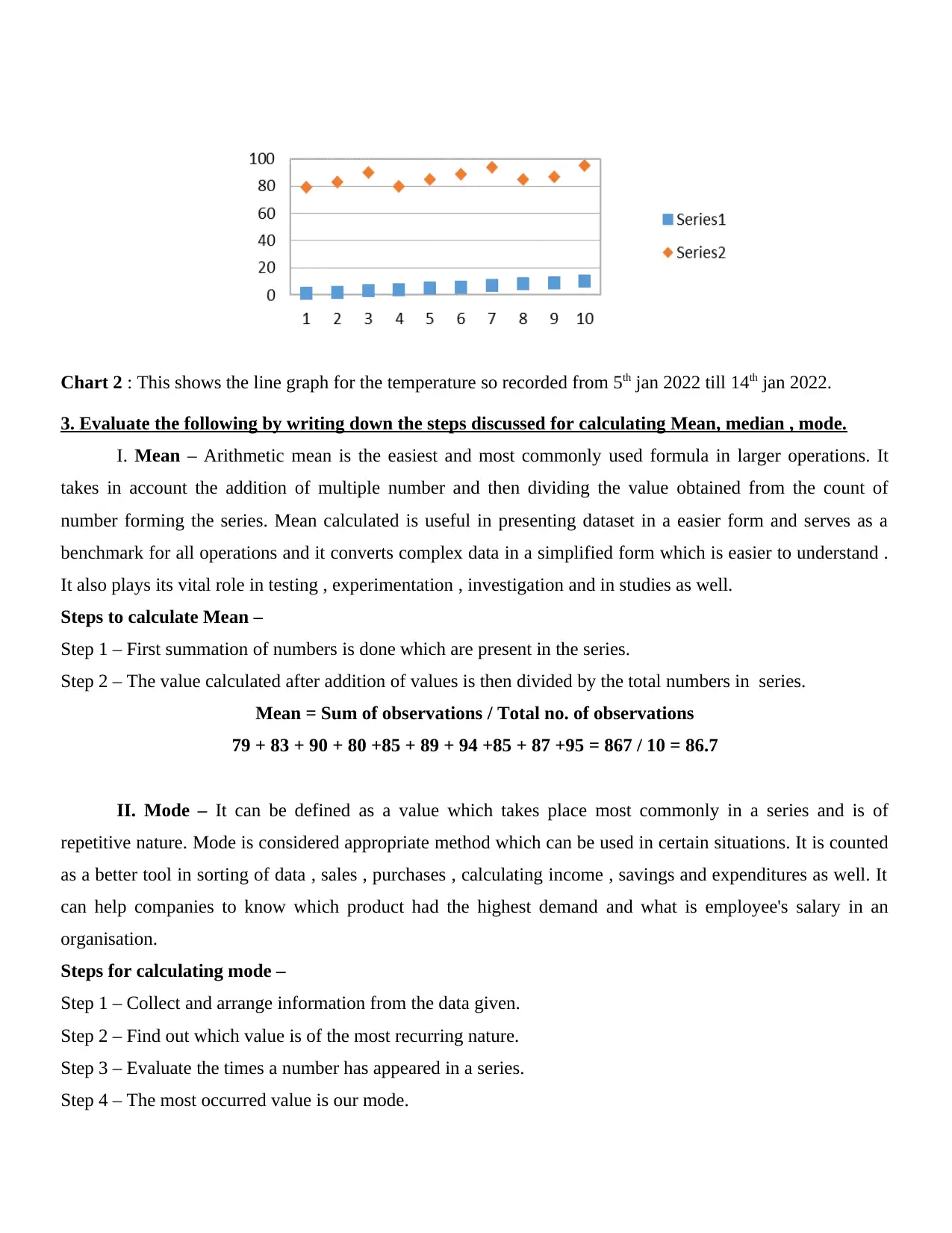
Chart 2 : This shows the line graph for the temperature so recorded from 5th jan 2022 till 14th jan 2022.
3. Evaluate the following by writing down the steps discussed for calculating Mean, median , mode.
I. Mean – Arithmetic mean is the easiest and most commonly used formula in larger operations. It
takes in account the addition of multiple number and then dividing the value obtained from the count of
number forming the series. Mean calculated is useful in presenting dataset in a easier form and serves as a
benchmark for all operations and it converts complex data in a simplified form which is easier to understand .
It also plays its vital role in testing , experimentation , investigation and in studies as well.
Steps to calculate Mean –
Step 1 – First summation of numbers is done which are present in the series.
Step 2 – The value calculated after addition of values is then divided by the total numbers in series.
Mean = Sum of observations / Total no. of observations
79 + 83 + 90 + 80 +85 + 89 + 94 +85 + 87 +95 = 867 / 10 = 86.7
II. Mode – It can be defined as a value which takes place most commonly in a series and is of
repetitive nature. Mode is considered appropriate method which can be used in certain situations. It is counted
as a better tool in sorting of data , sales , purchases , calculating income , savings and expenditures as well. It
can help companies to know which product had the highest demand and what is employee's salary in an
organisation.
Steps for calculating mode –
Step 1 – Collect and arrange information from the data given.
Step 2 – Find out which value is of the most recurring nature.
Step 3 – Evaluate the times a number has appeared in a series.
Step 4 – The most occurred value is our mode.
3. Evaluate the following by writing down the steps discussed for calculating Mean, median , mode.
I. Mean – Arithmetic mean is the easiest and most commonly used formula in larger operations. It
takes in account the addition of multiple number and then dividing the value obtained from the count of
number forming the series. Mean calculated is useful in presenting dataset in a easier form and serves as a
benchmark for all operations and it converts complex data in a simplified form which is easier to understand .
It also plays its vital role in testing , experimentation , investigation and in studies as well.
Steps to calculate Mean –
Step 1 – First summation of numbers is done which are present in the series.
Step 2 – The value calculated after addition of values is then divided by the total numbers in series.
Mean = Sum of observations / Total no. of observations
79 + 83 + 90 + 80 +85 + 89 + 94 +85 + 87 +95 = 867 / 10 = 86.7
II. Mode – It can be defined as a value which takes place most commonly in a series and is of
repetitive nature. Mode is considered appropriate method which can be used in certain situations. It is counted
as a better tool in sorting of data , sales , purchases , calculating income , savings and expenditures as well. It
can help companies to know which product had the highest demand and what is employee's salary in an
organisation.
Steps for calculating mode –
Step 1 – Collect and arrange information from the data given.
Step 2 – Find out which value is of the most recurring nature.
Step 3 – Evaluate the times a number has appeared in a series.
Step 4 – The most occurred value is our mode.
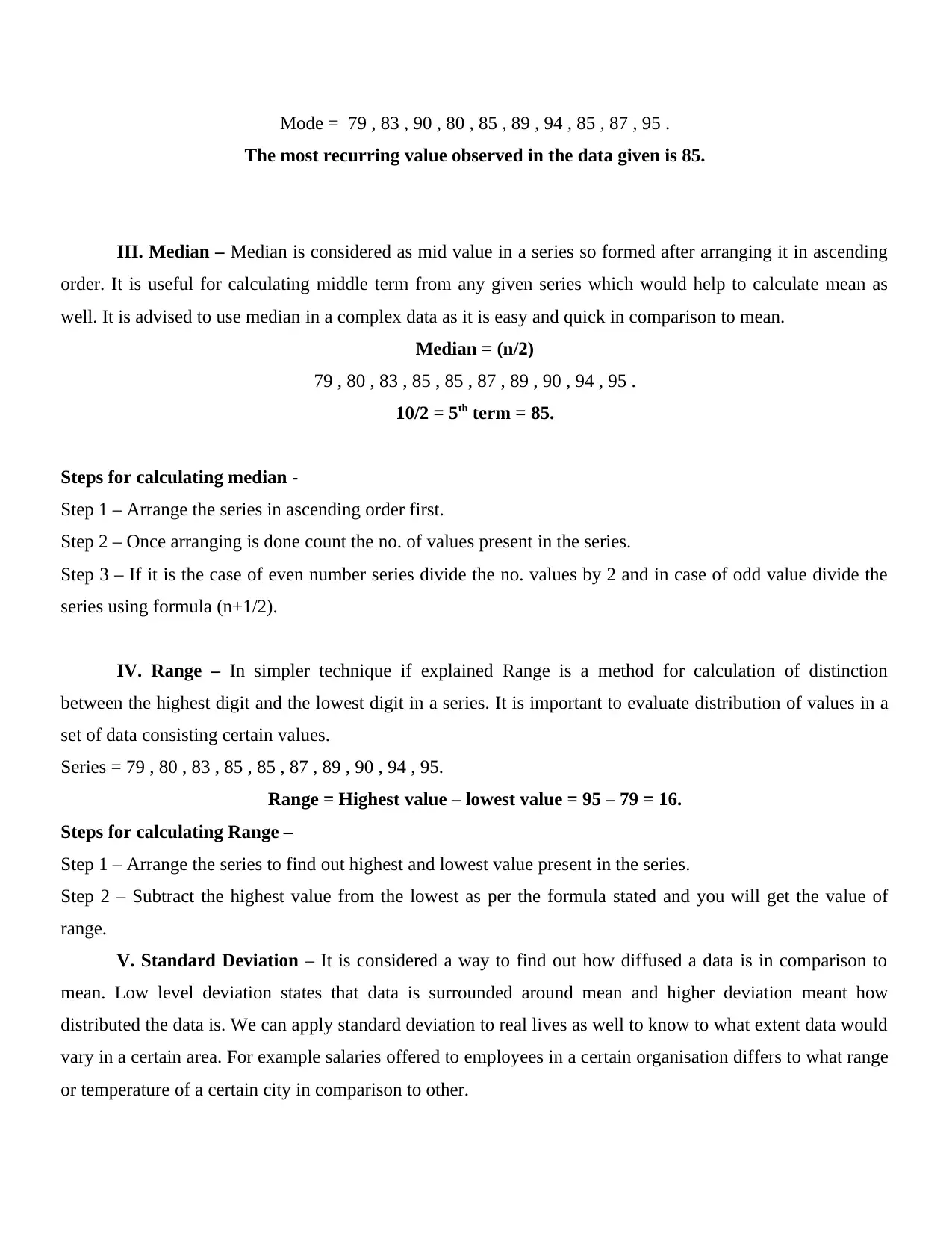
Mode = 79 , 83 , 90 , 80 , 85 , 89 , 94 , 85 , 87 , 95 .
The most recurring value observed in the data given is 85.
III. Median – Median is considered as mid value in a series so formed after arranging it in ascending
order. It is useful for calculating middle term from any given series which would help to calculate mean as
well. It is advised to use median in a complex data as it is easy and quick in comparison to mean.
Median = (n/2)
79 , 80 , 83 , 85 , 85 , 87 , 89 , 90 , 94 , 95 .
10/2 = 5th term = 85.
Steps for calculating median -
Step 1 – Arrange the series in ascending order first.
Step 2 – Once arranging is done count the no. of values present in the series.
Step 3 – If it is the case of even number series divide the no. values by 2 and in case of odd value divide the
series using formula (n+1/2).
IV. Range – In simpler technique if explained Range is a method for calculation of distinction
between the highest digit and the lowest digit in a series. It is important to evaluate distribution of values in a
set of data consisting certain values.
Series = 79 , 80 , 83 , 85 , 85 , 87 , 89 , 90 , 94 , 95.
Range = Highest value – lowest value = 95 – 79 = 16.
Steps for calculating Range –
Step 1 – Arrange the series to find out highest and lowest value present in the series.
Step 2 – Subtract the highest value from the lowest as per the formula stated and you will get the value of
range.
V. Standard Deviation – It is considered a way to find out how diffused a data is in comparison to
mean. Low level deviation states that data is surrounded around mean and higher deviation meant how
distributed the data is. We can apply standard deviation to real lives as well to know to what extent data would
vary in a certain area. For example salaries offered to employees in a certain organisation differs to what range
or temperature of a certain city in comparison to other.
The most recurring value observed in the data given is 85.
III. Median – Median is considered as mid value in a series so formed after arranging it in ascending
order. It is useful for calculating middle term from any given series which would help to calculate mean as
well. It is advised to use median in a complex data as it is easy and quick in comparison to mean.
Median = (n/2)
79 , 80 , 83 , 85 , 85 , 87 , 89 , 90 , 94 , 95 .
10/2 = 5th term = 85.
Steps for calculating median -
Step 1 – Arrange the series in ascending order first.
Step 2 – Once arranging is done count the no. of values present in the series.
Step 3 – If it is the case of even number series divide the no. values by 2 and in case of odd value divide the
series using formula (n+1/2).
IV. Range – In simpler technique if explained Range is a method for calculation of distinction
between the highest digit and the lowest digit in a series. It is important to evaluate distribution of values in a
set of data consisting certain values.
Series = 79 , 80 , 83 , 85 , 85 , 87 , 89 , 90 , 94 , 95.
Range = Highest value – lowest value = 95 – 79 = 16.
Steps for calculating Range –
Step 1 – Arrange the series to find out highest and lowest value present in the series.
Step 2 – Subtract the highest value from the lowest as per the formula stated and you will get the value of
range.
V. Standard Deviation – It is considered a way to find out how diffused a data is in comparison to
mean. Low level deviation states that data is surrounded around mean and higher deviation meant how
distributed the data is. We can apply standard deviation to real lives as well to know to what extent data would
vary in a certain area. For example salaries offered to employees in a certain organisation differs to what range
or temperature of a certain city in comparison to other.
⊘ This is a preview!⊘
Do you want full access?
Subscribe today to unlock all pages.

Trusted by 1+ million students worldwide

Days
Temperatur
e
Standard
devitaion S.D.2
1 79 -7.7 59.29
2 83 -3.7 13.69
3 90 3.3 10.89
4 80 -6.7 44.89
5 85 -1.7 2.89
6 89 2.3 5.29
7 94 7.3 53.29
8 85 -1.7 2.89
9 87 0.3 0.09
10 95 8.3 68.89
867 262.1
Mea
n 86.7 -2.84
Steps for calculating standard deviation –
Step 1 – Calculate mean.
Step 2 – Find square for each value point and distance to mean.
Step 3 – Calculate the value by summing of values from step 2.
Step 4 – Divide the value by the number of digits present in the series.
Step 5 – Calculate square root.
Standard Deviation = S.D = √ (xi- μ⅀ )2 / N = √(262.1)2 /10 = √26.21 = 5.119 .
4. Calculate the value of m and c using the linear regression. Also forecast the value of y for 11th & 12th
day.
I. N stands for number of values in a series
X stands for 10 consecutive days of humidity.
Y stands for temperature recorded for the city.
XY stands for multiplication of humidity days and temperature.
Temperatur
e
Standard
devitaion S.D.2
1 79 -7.7 59.29
2 83 -3.7 13.69
3 90 3.3 10.89
4 80 -6.7 44.89
5 85 -1.7 2.89
6 89 2.3 5.29
7 94 7.3 53.29
8 85 -1.7 2.89
9 87 0.3 0.09
10 95 8.3 68.89
867 262.1
Mea
n 86.7 -2.84
Steps for calculating standard deviation –
Step 1 – Calculate mean.
Step 2 – Find square for each value point and distance to mean.
Step 3 – Calculate the value by summing of values from step 2.
Step 4 – Divide the value by the number of digits present in the series.
Step 5 – Calculate square root.
Standard Deviation = S.D = √ (xi- μ⅀ )2 / N = √(262.1)2 /10 = √26.21 = 5.119 .
4. Calculate the value of m and c using the linear regression. Also forecast the value of y for 11th & 12th
day.
I. N stands for number of values in a series
X stands for 10 consecutive days of humidity.
Y stands for temperature recorded for the city.
XY stands for multiplication of humidity days and temperature.
Paraphrase This Document
Need a fresh take? Get an instant paraphrase of this document with our AI Paraphraser
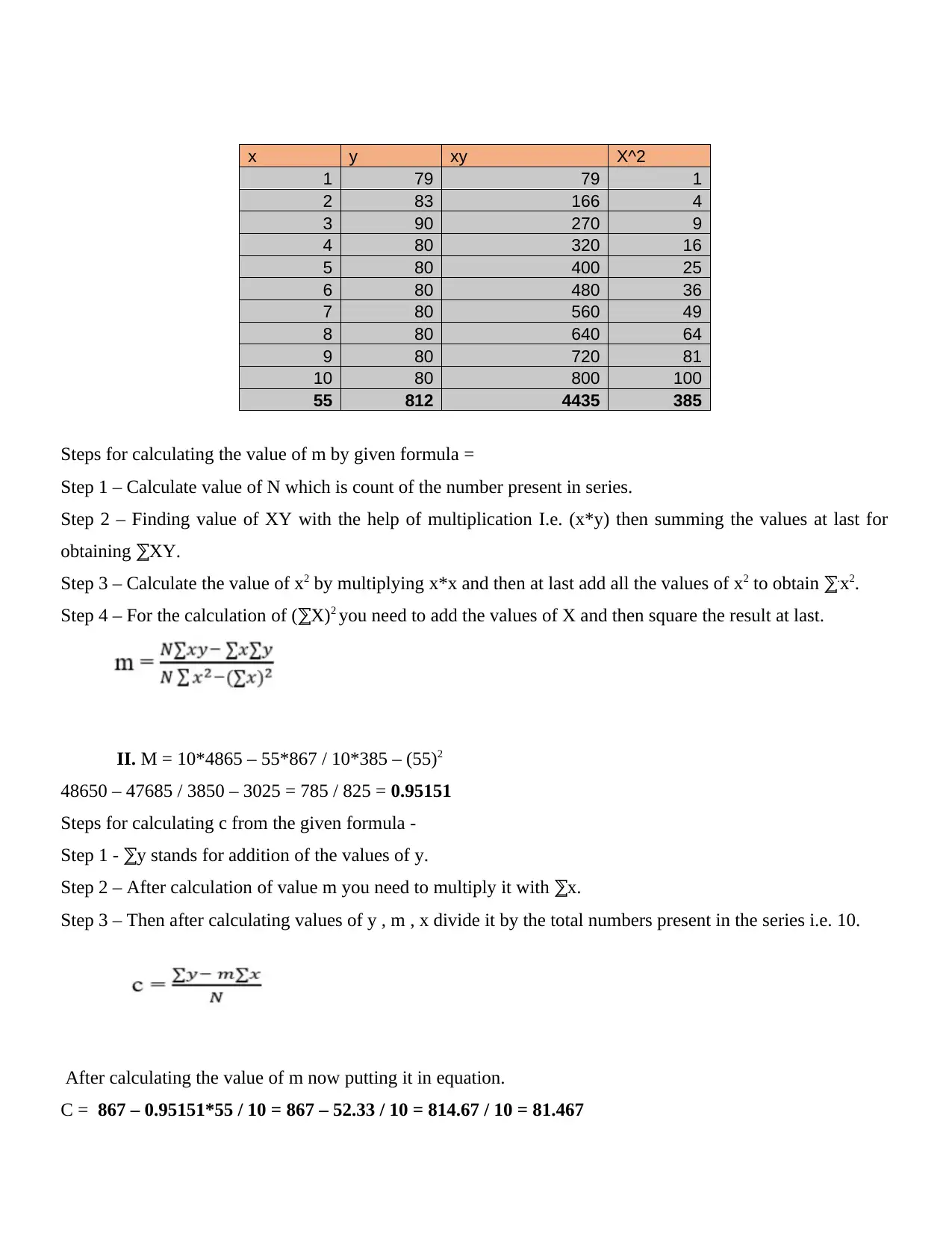
x y xy X^2
1 79 79 1
2 83 166 4
3 90 270 9
4 80 320 16
5 80 400 25
6 80 480 36
7 80 560 49
8 80 640 64
9 80 720 81
10 80 800 100
55 812 4435 385
Steps for calculating the value of m by given formula =
Step 1 – Calculate value of N which is count of the number present in series.
Step 2 – Finding value of XY with the help of multiplication I.e. (x*y) then summing the values at last for
obtaining XY.⅀
Step 3 – Calculate the value of x2 by multiplying x*x and then at last add all the values of x2 to obtain ⅀.x2.
Step 4 – For the calculation of ( X)⅀ 2 you need to add the values of X and then square the result at last.
II. M = 10*4865 – 55*867 / 10*385 – (55)2
48650 – 47685 / 3850 – 3025 = 785 / 825 = 0.95151
Steps for calculating c from the given formula -
Step 1 - y stands for addition of the values of y.⅀
Step 2 – After calculation of value m you need to multiply it with x.⅀
Step 3 – Then after calculating values of y , m , x divide it by the total numbers present in the series i.e. 10.
After calculating the value of m now putting it in equation.
C = 867 – 0.95151*55 / 10 = 867 – 52.33 / 10 = 814.67 / 10 = 81.467
1 79 79 1
2 83 166 4
3 90 270 9
4 80 320 16
5 80 400 25
6 80 480 36
7 80 560 49
8 80 640 64
9 80 720 81
10 80 800 100
55 812 4435 385
Steps for calculating the value of m by given formula =
Step 1 – Calculate value of N which is count of the number present in series.
Step 2 – Finding value of XY with the help of multiplication I.e. (x*y) then summing the values at last for
obtaining XY.⅀
Step 3 – Calculate the value of x2 by multiplying x*x and then at last add all the values of x2 to obtain ⅀.x2.
Step 4 – For the calculation of ( X)⅀ 2 you need to add the values of X and then square the result at last.
II. M = 10*4865 – 55*867 / 10*385 – (55)2
48650 – 47685 / 3850 – 3025 = 785 / 825 = 0.95151
Steps for calculating c from the given formula -
Step 1 - y stands for addition of the values of y.⅀
Step 2 – After calculation of value m you need to multiply it with x.⅀
Step 3 – Then after calculating values of y , m , x divide it by the total numbers present in the series i.e. 10.
After calculating the value of m now putting it in equation.
C = 867 – 0.95151*55 / 10 = 867 – 52.33 / 10 = 814.67 / 10 = 81.467

III.Linear forecasting model
y = mx+c
m value = 0.95151 , x value = 11 , c value = 81.67 , Y stands for humidity.
Y value for 11th day = 0.951 * 11 + 81.67 = 92.131
m value = 0.95151 , x value = 13 , c value = 81.67.
Y value for 13th day = 0.951 * 13 + 81.67 = 94.033
Conclusion – From the above mentioned report it can be concluded that the Table highlights humidity data
recorded for the past 10 consecutive days in Scotland with the help of graphs and certain tools as well . It
further explains methods and steps followed to forecast temperature for 11th and 13th day as well which is
92.131 and 94.033. It is useful in providing a better understanding of Data analysis and Numeracy which
includes linear equations , forming tables etc.
y = mx+c
m value = 0.95151 , x value = 11 , c value = 81.67 , Y stands for humidity.
Y value for 11th day = 0.951 * 11 + 81.67 = 92.131
m value = 0.95151 , x value = 13 , c value = 81.67.
Y value for 13th day = 0.951 * 13 + 81.67 = 94.033
Conclusion – From the above mentioned report it can be concluded that the Table highlights humidity data
recorded for the past 10 consecutive days in Scotland with the help of graphs and certain tools as well . It
further explains methods and steps followed to forecast temperature for 11th and 13th day as well which is
92.131 and 94.033. It is useful in providing a better understanding of Data analysis and Numeracy which
includes linear equations , forming tables etc.
⊘ This is a preview!⊘
Do you want full access?
Subscribe today to unlock all pages.

Trusted by 1+ million students worldwide
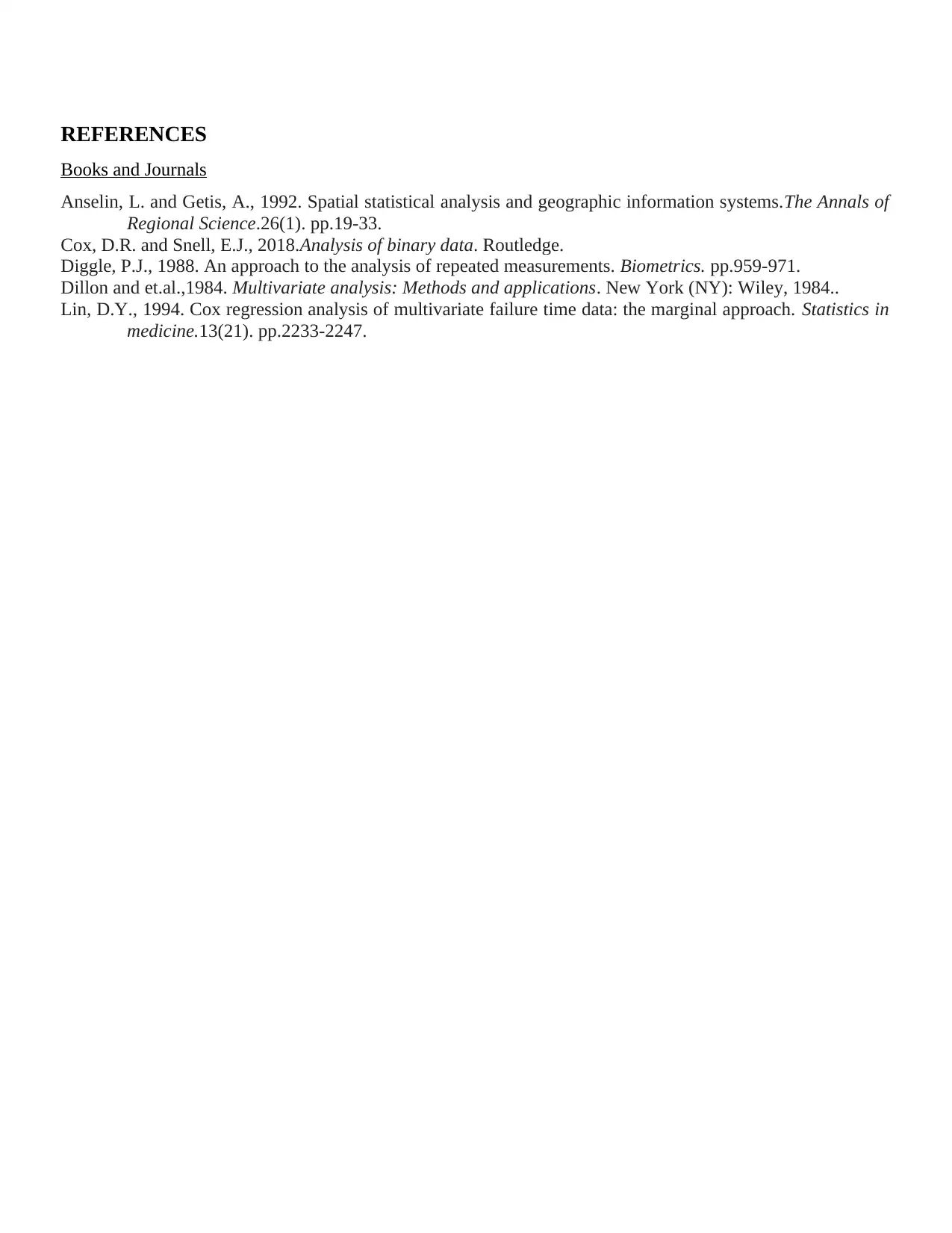
REFERENCES
Books and Journals
Anselin, L. and Getis, A., 1992. Spatial statistical analysis and geographic information systems.The Annals of
Regional Science.26(1). pp.19-33.
Cox, D.R. and Snell, E.J., 2018.Analysis of binary data. Routledge.
Diggle, P.J., 1988. An approach to the analysis of repeated measurements. Biometrics. pp.959-971.
Dillon and et.al.,1984. Multivariate analysis: Methods and applications. New York (NY): Wiley, 1984..
Lin, D.Y., 1994. Cox regression analysis of multivariate failure time data: the marginal approach. Statistics in
medicine.13(21). pp.2233-2247.
Books and Journals
Anselin, L. and Getis, A., 1992. Spatial statistical analysis and geographic information systems.The Annals of
Regional Science.26(1). pp.19-33.
Cox, D.R. and Snell, E.J., 2018.Analysis of binary data. Routledge.
Diggle, P.J., 1988. An approach to the analysis of repeated measurements. Biometrics. pp.959-971.
Dillon and et.al.,1984. Multivariate analysis: Methods and applications. New York (NY): Wiley, 1984..
Lin, D.Y., 1994. Cox regression analysis of multivariate failure time data: the marginal approach. Statistics in
medicine.13(21). pp.2233-2247.
1 out of 10
Related Documents
Your All-in-One AI-Powered Toolkit for Academic Success.
+13062052269
info@desklib.com
Available 24*7 on WhatsApp / Email
![[object Object]](/_next/static/media/star-bottom.7253800d.svg)
Unlock your academic potential
Copyright © 2020–2026 A2Z Services. All Rights Reserved. Developed and managed by ZUCOL.



